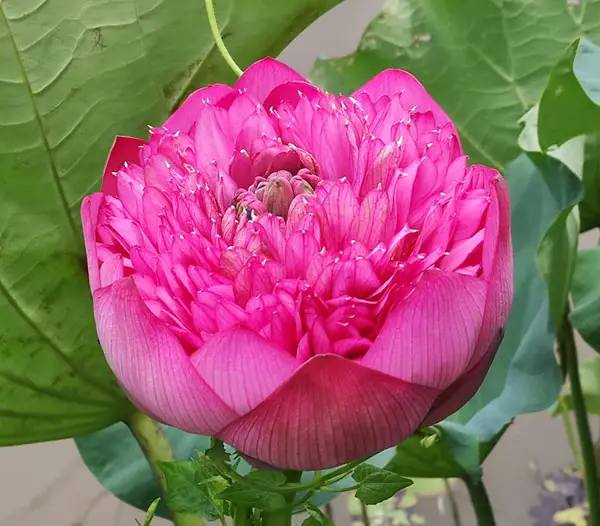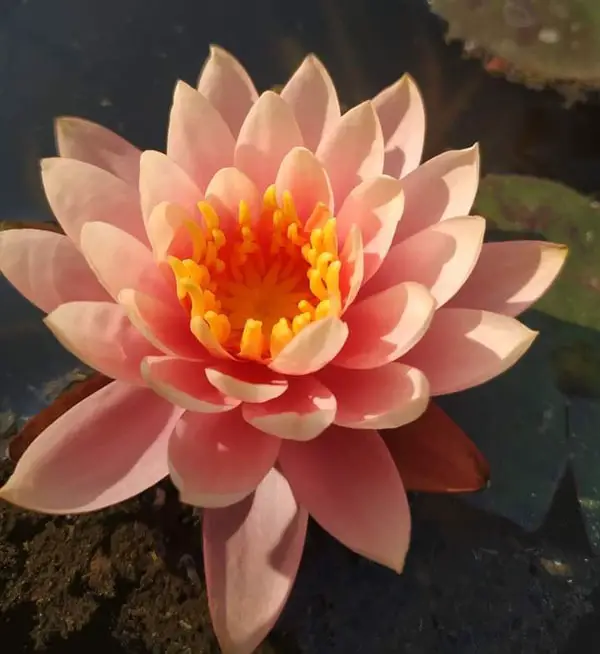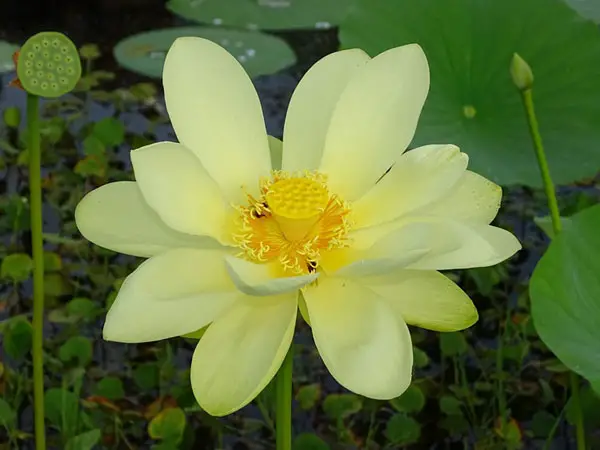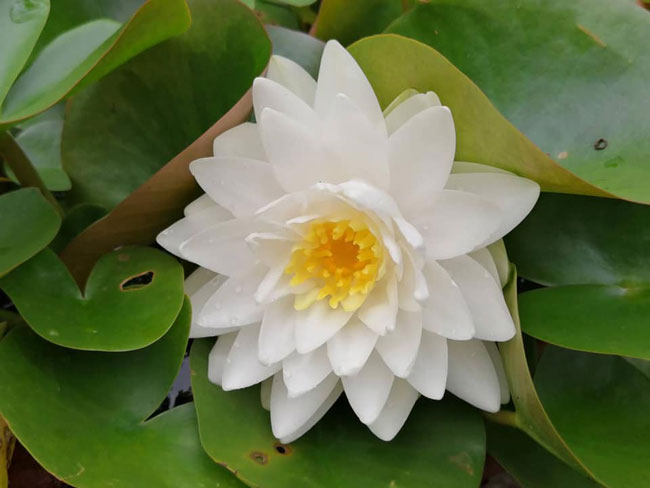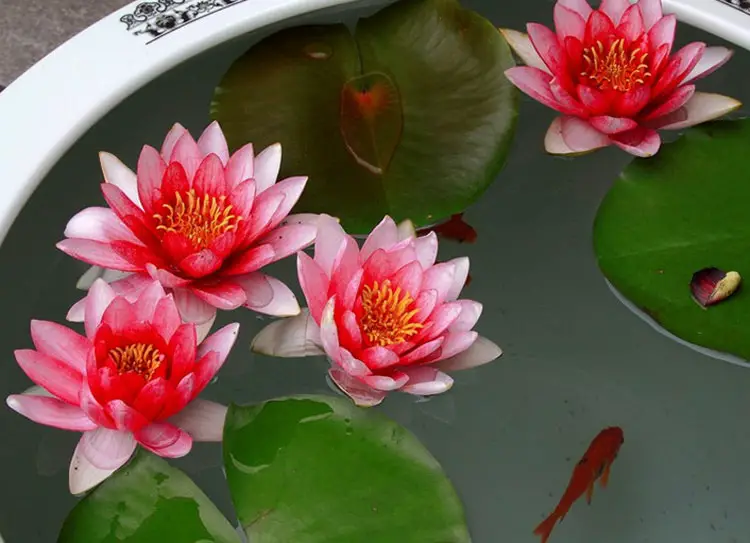There are many types of lotus, and they can be divided into two categories: ornamental and edible.
Most of the lotus plants are native to tropical regions of Asia. Lotus is a perennial emergent herbaceous plant belonging to the genus Nymphaeaceae. The world always praises its sludge and unstained character.
The lotus has a strong ability to adapt to the growth environment. It not only growing in lakes and ponds, but even in small pots and bowls, it can also grow very well.
Pure Flowers For Buddhists
The lotus is the national flower of India. India is the birthplace of Buddhism, and therefore, the lotus and the Buddha are connected.
Buddha is said to have been born in the heart of a lotus and is often represented sitting either on a flower or floating on its leaf. Buddhist temples display lotus for protection and love, and the scent is said to have the power to guard whoever breathes it.
The plant is amazingly viable. Japanese paleontologists who found 1,000-year-old seeds in Manchuria in 1951 planted them, and two produced beautiful flowers – identical to the kind of blossoms grown today. It seems the lotus never changes.
Since there are many types of lotus available globally, I would love to share some of the species that commonly grow by people.
1. Graceful Guanyin Lotus
This type of lotus has many different colors. This variety of lotus can shines and ignites the enthusiasm of a season. The flower of this lotus is deep purple in warm weather and will turn pink in cold weather.
The Graceful Guanyin Lotus is an extraordinary tropical flower. The edge of the leaf is jagged, the leaf’s surface is green, with small light brown spots, and the back of the leaf is flushed. The leaf ears cover each other with 8 green leaf-like sepals. The flower shape is peculiar, and the color pales red.
It likes to grow in a ventilated and sunny environment. It is not so tolerant of cold weather. It is mostly distributed in tropical areas. Its flowers will close at night and open during the day.
2. Egyptian Lotus
Egyptian lotus (botanical name: Nymphaea caerulea Savigny) is a perennial aquatic herb with round or ovoid floating leaves, and the submerged leaves are thin and fragile.
The Egyptian lotus is beautiful in shape and floats or rises above the water surface. It usually blooms in the evening and closes in the early afternoon. The flowers are fragrant.
Egyptian lotus like a hot, humid, and sunny environment. Although the name contains Egypt, they are actually native to North Africa and Mexico.
In ancient Egyptian mythology, the sun was born from the blooming of lotus flowers, and the lotus was regarded as the “sacred flower.” The flower then became a totem on the pillars of ancient Egyptian temples, symbolizing the blessing of “there is only beginning, not disillusionment.”
The ancient Egyptians used the blue lotus as a symbol of life for a long time. The blue lotus, which never fades, is like endless life. The flowers are important to be used in funerals for Egyptians.
They believe that lotus will help for the rebirth of the dead. So Egyptian lotus has always held a significant position in the Egyptian faith.
3. Thousand Petal Lotus
The most ornamental lotus species is Thousand Petal Lotus. It is a rare ornamental plant in the Nymphaeaceae family. It blooms in midsummer every year and the flowering period lasts as long as 3 months.
After careful cultivation by experts, Now there are many precious species available after various researches and cultivation did by different experts.
Thousand Petal Lotus is a Buddhist sacred plant, which has been used by Buddhists at least 1500 years ago.
It is reported that the original lotus species we are familiar with are those with complete pistil and a limited number of petals. After long-term artificial cultivation, the pistils and stamens of the lotus varieties continued to improve, and the number of petals continued to increase. Finally, it evolved into the thousand petals of the pistils and stamens.
Thousand Petal Lotus is pink with overlapping petals. The outer petals are large, and the inner petals gradually become smaller. The smallest petal is only as large as a rice grain.
Before budding, it looks like a peach from a far distance. When it is budding, the petals are stacked on top of each other, looking like a dahlia.
This variety is costly. Its petals will grow and fall at the same time. Each flower of a Thousand-petal lotus has 1,000 petals. Some can even have up t 4,500 petals.
Thousand Petal Lotus can produce two flowers with one stem, and each flower has a stalk. The stalks are connected to the flower stem.
It is a treasure flower for people, and many regard the double lotus as a sign of auspiciousness and joy and the embodiment of kindness and beauty.
4. Sacred Lotus
The Sacred lotus (botanical name: Nelumbo nucifera) is also a species of lotus. It is one of the oldest lotus and also one of the earliest angiosperms of its origin.
This flower has been planted as early as a thousand years ago. The Sacred lotus has strong vitality and can be planted in a pond or a lake. The Sacred lotus usually blooms in June each year, and its flower only blooms for one month.
It is one of the most beautiful flowers in the world and is held in high esteem in the East. Lotus legends abound: One description has it as “the womb of creation, from its blossom the creative aspect of God, Brahma, came forth.”
The lotus grows in shallow water, and the fact it produces such stunning flowers from the mud “suggests both purity and immortality … a symbol of beauty in the Orient.”
5. White Summer Snow Lotus
Wild White Summer Snow Lotus mainly grows in swamp areas, so this plant has high requirements for the humidity in the growing environment. The origin area of the White Summer Snow Lotus was in the central and southern regions of Europe, Romania, and Western Russia.
Domestic White Summer Snow Lotus is mostly grown by hydroponics. If you want to grow them with soil, you need to water them frequently to maintain a moist and cool environment.
You need to use the soil that is rich in humus to grow the White Summer Snow Lotus. This flower has a certain degree of cold resistance. You can place it in a sunny place or a semi-shade environment.
If the plant is properly maintained, it can keep an evergreen state in winter because it has the characteristics of strong adaptability.
In the early spring period, the plant can produce pure and beautiful flowers. Therefore, this plant is very suitable for planting in winter as it has a high ornamental value.
White Summer Snow Lotus can represent purity because the flower color is white and is pollution-free. This gives people an exquisite and holy feeling.
You can also plant White Summer Snow Lotus in a pot and place it indoors. This can provide a good decoration for your home and purify the air at the same time.
6. American Lotus (Nelumbo lutea)
The American Lotus (botanical name: Nelumbo lutea) commonly grows in lakes, swamps, and flooded areas. You can find them in Florida, Texas, North Massachusetts, New York, Minnesota, Iowa, Ontario, Canada, Mexico, West Indies (Cuba, Jamaica, and Hispaniola), and Central America (Honduras).
The American Lotus is a widely planted flower. It is a foliage plant that reproduces through rhizomes and seeds and has become an invasive plant in some areas.
The American Lotus is often crossed with other lotus and producing many hybrids. You can propagate the seeds by cutting the seed coat at the tip of the seed and soaking in water or by dividing the rhizome.
Native Americans treat the lotus root of the plant as food, which is called “Macoupin” in Miami-Illinois. The distribution area of the American Lotus is expanding to the northern United States because the native Americans used this plant as food, and they may have propagated the plant to the northern United States.
7. Vietnamese Lotus
In Vietnam, the lotus image is almost everywhere, and there are blooming lotus and lotus patterns and shapes everywhere. This is true from the people at the bottom to the emperor.
The Vietnamese Lotus is pure, simple, and fragrant. Lotus is closely related to the lives of the Vietnamese. In summer, the sun is shining, the lotus leaves can shade, and you can fold the lotus leaves like an umbrella on rainy days.
For working people, the lotus leaf has many uses. You can use it to contain food and take it to the farming fields. Lotus is an indispensable subject matter in Vietnamese folk songs and proverbs.
The lotus flower is a symbol of love. It is used as a metaphor for lovers who are shy to express their love.
For example, “I have never known you before, but have there ever been lotus plants in the small lake? The small lake is still clean and dust-free, waiting for the lotus to come wholeheartedly.”
“Yesterday. Next to the pavilion, the rags are left on the lotus branch. If the girl finds it, please return it to me, or keep it in the house as a token?”
In the hearts of every Vietnamese, whenever they talk about the Vietnamese Lotus, people can’t help but think of the rustic and pure scenery of the countryside. The people have deep love and compassion for it.
Vietnamese people often use flowers to depict beautiful women. Perhaps no flower can depict the simplicity and beauty of a woman like a Vietnamese Lotus.
8. Mexican Lotus
Mexican Lotus (botanical name: Nymphaea Mexicana Zucc.)is a perennial aquatic herb with thick rhizomes.
The floating leaves are round or oval, while the base is curved, heart-shaped, or arrow-shaped. The submerged leaves are thin and fragile.
The flower is large, beautiful, and floating above the water. The petals are in multiple rounds with the shape of a carpel ring. It will be semi-submerged in a fleshy cup-shaped receptacle and partially connect with the lower part.
The upper part is concave into the stigma disk, the ovule is inverted, and hangs down on the inner wall of the ovary. The berry is spongy, irregularly cracked, and matures under the water. The seed is hard and is wrapped in gum. The Mexican Lotus is flowering in August each year, and they are beautiful for viewing.
The flower represents cleanness, innocent, and glamorous. Anyone born under the blessing of this flower is born with an irresistible charm for people.
9. Chromatella Lotus
Most of Chromatella Lotus (botanical name: Nymphaea tetragona) flowers are native to tropical regions of North Africa and Southeast Asia, and a few are produced in the temperate and frigid regions of South Africa, Europe, and Asia, Japan, Korea, India, the former Soviet Union, Siberia, Europe, and The United States.
The adult leaves are green, and the spots gradually disappear. The petals are yellow. The flower center is dark yellow, and about 25 petals for each lotus.
The flower is small and suitable for planting in pots and bowls. In winter, the main bud of the mother stem is easy to rot. However, the plant will still have a lot of side buds.
This species is a small and medium-sized lotus. The larger the container, the larger the leaves and the larger the blossoms.
Cromartilla Lotus is a perennial herb with nearly round and paper-like leaves. The leaves are deep bend at the base, nearly parallel or spreading, and full or wavy.
The stem is a creeping rhizome. The fruit is a berry with a flat to hemispherical shape or an oval seed. The flowering period for Chromatella Lotus is from June to August, and the bear fruit period is from August to October.
Cromartilla Lotus loves to grow in sufficient sunlight, good ventilation, and soil rich in organic material.
10. Hardy Lotus
The Hardy Lotus is a perennial aquatic herb. The rhizome is short and thick. The leaves are papery, while the new leaves are green with slightly copper-colored. The back is dark copper-colored.
The leaves are oval, and the base of the leaf is wide open in a “V” shape. The petioles are mostly green with thick hair. The leaf diameter is about 15-20 cm, and it can spread to 1 meter – 1.2 meters.
Hardy Lotus that bloom during the day will shut at night and bloom again in the morning. A pond with a shade of trees on the shore is ideal for the plant.
The plant is not harsh on soil quality. As long as the pH value is between 6-8 and the soil is rich with organic material, it can grow nicely. The ideal water depth is 25-30 cm, and the deepest must not exceed 80 cm.
Hardy Lotus is commonly planted in small, medium, or large ponds. One of its outstanding features is that the flowers can continue to bloom until late in the afternoon since flowers can continue to bloom until the afternoon.
11. Masaniello Lotus
The Masaniello Lotus(botanical name: Nymphaea ‘Masaniello) flower opens in the morning and shuts in the afternoon. The plant is floating on the water. The single plant flowering period is about 3 to 4 days, while the group flowering period is from late April to early October.
The flower is cup-shaped, with darker red petals in the inner ring and lighter red in the outer ring. You can smell slightly fragrant when you get close to the flower.
The leaves are nearly round, and the leaf surface is green. The back of the young leaves is purple-red. It features malilek type of rhizomes. Suitable for a water depth of 45cm-90cm.
The Masaniello Lotus symbolizes purity. These plants usually grow in the clear water, standing tall and slim. When you take a look from a distance, it is like a lovely girl. When you touch it lightly, it will shut it off immediately. This symbolized the sacred, clean and inviolable of the plant.
12. Blue Star Lotus
Blue Star Lotus (botanical name: Nymphaea nuchali) is also called blue water lily, or by its synonym Nymphaea stellata. It is a genus Nymphaea lotus.
The plant is originated from Bangladesh, Sri Lanka, India, and Australia. It has been long valued as a garden flower in Myanmar and Thailand as a great decoration for garden ponds.
According to some records, this flower appeared in ancient Egypt. It is a must in the coffin of the mummy and has an antiseptic effect. The Blue Start Lotus is the national flower of Sri Lanka. It is also the favorite flower for the Buddha of the Sri Lankan Buddhists.
The plant has a stout rhizome. The leaves are round or nearly round. The shape of the leaf is larger with irregular teeth on edge. It is green at the front and pink or lavender at the back.
The flower is light blue, and the petals radiate in a star shape. The petals are narrow at the tip, slightly wider at the base, and fragrant.
There are around 15-18 petals for a flower, and the flower diameter is about 15 cm. The male stamens are of golden color. There are small black spots on the calyx, and the sepals are linear or oblong-lanceolate. The pedicels stand above the water. The flowers generally bloom in the morning and shut in the afternoon.
The roots, stems, leaves, flowers, and seeds of this flower can be used as medicine. You can soak yourself with the flowers in water for 24 hours, which can eliminate all kinds of poisons from the body.
The blue lotus is a symbol of eternal love. Just like its blue-purple flower color, it represents eternal and long-lasting meaning. Its long floral fragrance seems to be able to stay in people’s hearts for a long, long time. People like to give the blue lotus to the one they like, expressing the hope that love and beauty will last forever.
13. Colorado Lotus
This type of lotus is known as Colorado Lotus or Nymphaea’Colorado’. The flower opens in the morning and shuts in the afternoon. The flowering period for the individual flower is 3 to 4 days, and the group flowering period is from early June to early November.
The flowers are orange-yellow in color while the plants are at low temperature, and the color will turn orange-red while the temperature is high; The flower is star-shaped, and the leaves are round. The surface of the leaf is green, and the edge of the back leaf is slightly flushed. It is suitable to be planted at a water depth of 45-90cm.
Colorado Lotus is an excellent lotus variety for horticulturists from all over the world. It can bloom many flowers, and the flowers are large.
Every year in early spring and February, the Colorado Lotus will quietly open up. Blossoming flowers stand proudly on the clear water surface, full of enthusiasm and fragrance.
People looking for spring outings can wander around the Colorado Lotus, and they will feel the strong breath of spring.
The Colorado lotus symbolizes freedom. The plant itself contains a spirit that is extremely eager to pursue freedom. It can face any obstacles. This spirit has always encouraged people to face difficulties bravely and try to solve them. The flower can imply people face their lives positively and optimistically.
14. Helvola Lotus
Helvella Lotus(botanical name: Nymphaea ‘Pygmaea Helvola’) is a perennial aquatic herb.
The flower opens in the afternoon and shuts at night. The flowers are float on the water. The flowering period for the individual flower is 3-4 days, while the group flowering period is from late May to late September.
The flowers are cup-shaped and star-shaped. They are of yellow color with lightly fragrant. The leaves are ovoid in shape. The surface of the leaf is green, with dark stripes and dark purple patches. The back of the leaves is red with dark purple spots. The rhizomes are finger-shaped. The suitable water depth for Helvola Lotus to grow is between 15-23cm.
The Helvola Lotus symbolizes wisdom. According to legend, a monk struggled to find a lotus that never faded on a mountain. After many years of struggling, he finally has found the Helvola Lotus. Unfortunately, the flower was already withered. But the monk realized the truth even though he found a withered flower, as long as there is a flower in the heart, it will never wither.
15. King Lotus
King lotus is a famous water viewing plant. It is also one of the largest aquatic plants in the world. A German botanist found the plant in 1801 in a tributary of the Amazon River.
The largest King Lotus can reach about 3 meters in diameter. It can withstand up to 70 kg of heavy objects without sinking into the water. Studies have found that they are adapted to high temperature and high humidity environments.
But it is not cold-resistant. When the temperature is below 20℃, its growth will be slow down or even stagnant. It will die if the temperature is reached 8℃.
In 1850, King Lotus was successfully introduced to Europe. And not until 1959, the seeds of King Lotus were then introduced to China from Germany and successfully cultivated in the greenhouse. Many China people then relished it, and they planted the plant widely everywhere in the country.
King Lotus likes to live in the fertile swamp where the sludge in the cultivation pool cannot exceed 50 cm. The depth of the water depth should not exceed 1 meter.
Regular fertilization is required when planting King Lotus, and topdressing is required 1-2 times during the leaf growth and flowering.
Only taking care of King Lotus in this way can ensure the plant grows up healthily and holding heavy objects. So don’t think the King Lotus that you plant in your pond is strong enough to hold you up, and you try to sit on it. Otherwise, it will be embarrassing if it makes you fall into the water.
Did you find this post useful? Would you like to get back to it later? Save THIS PIN below to your flower and plant garden boards on Pinterest! Thanks 🙂




